一、缓存里的数据如何和数据库的数据保持一致?
如果实时性、一致性要求高的,不是读多写少的,就直接去数据库查,不必缓存到redis中,不必过度设计
1、缓存数据一致性-双写模式
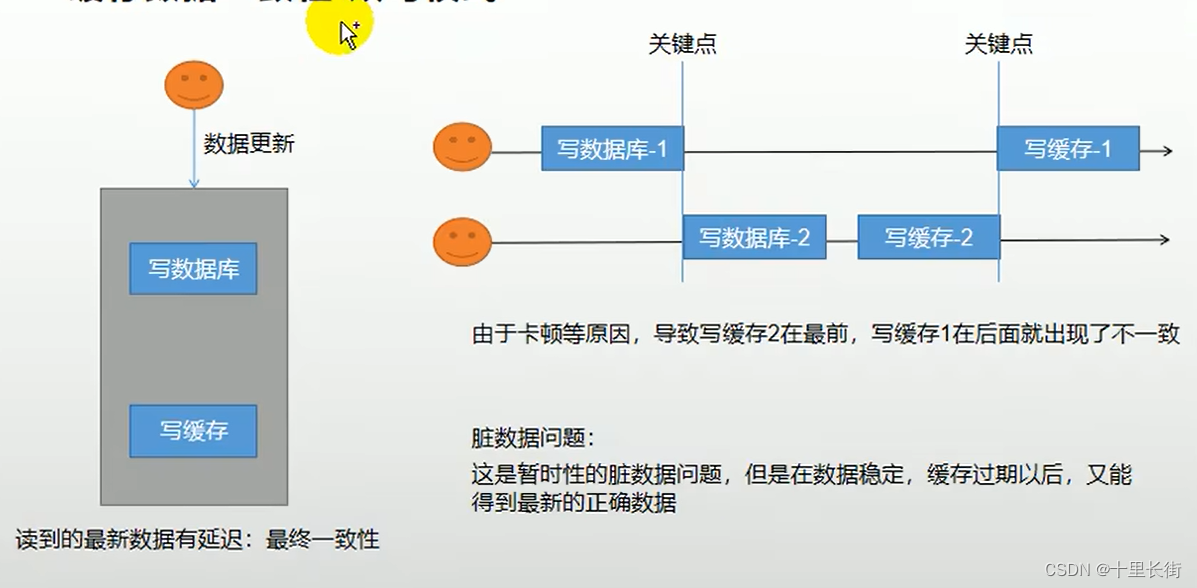
伪代码如下:
public boolean saveToDb() {
//1.更新数据库
baseMapper.insert(category);
//2.更新缓存数据
stringRedisTemplate.opsForValue().set("key","value");
}
2、 缓存数据一致性-失效模式
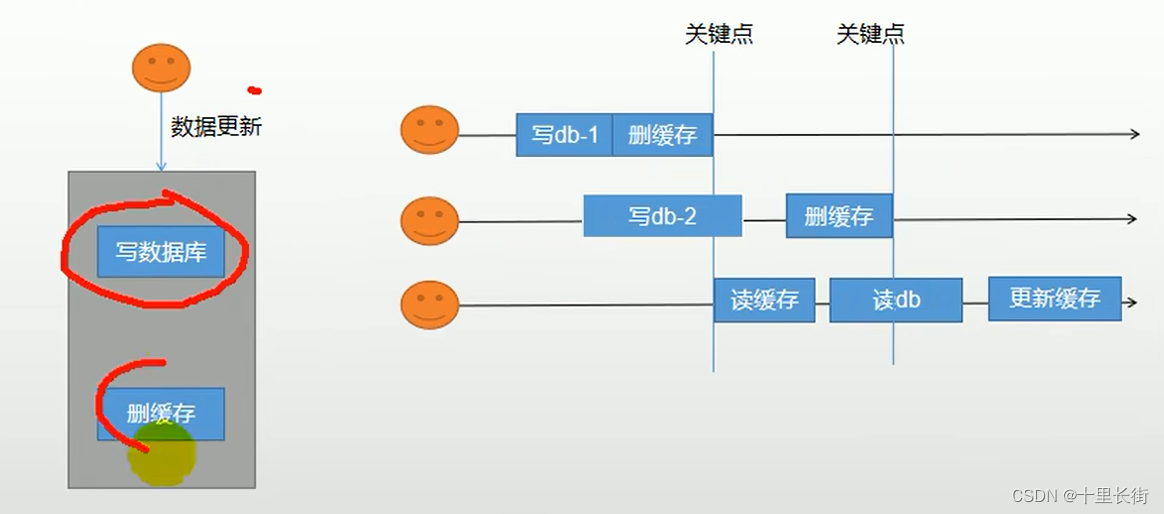
伪代码如下:
public boolean saveToDb() {
//1.更新数据库
baseMapper.insert(category);
//2.删除缓存数据
stringRedisTemplate.delete("key");
}
//3.需要用到缓存数据的另一方法再去查询数据库,再保存到缓存中
3、能容忍暂时性脏数据的存在,只要能实现最终一致性,可将缓存数据添加过期时间,能够解决大部分业务问题
#spring.cache.cache-names=qq,毫秒为单位
spring.cache.redis.time-to-live=3600000
4、读写锁+删除或更新缓存数据/过期时间(我们系统的一致性解决方案)
缓存的所有数据都有过期时间,数据过期下一次查询触发主动更新
读写数据的时候,加上分布式的读写锁。经常读写对此会有很大的影响
#spring.cache.cache-names=qq,毫秒为单位
spring.cache.redis.time-to-live=3600000
/**
* 写数据用写锁
* 级联更新所有关联的数据
*/
@CacheEvict(value = "category", allEntries = true)//删除某个分区下的所有数据
@Override
public void updateCascade(CategoryEntity category) {
RReadWriteLock readWriteLock = redissonClient.getReadWriteLock("catalogJson-lock");
//创建写锁
RLock rLock = readWriteLock.writeLock();
try {
rLock.lock();
this.baseMapper.updateById(category);
categoryBrandRelationService.updateCategory(category.getCatId(), category.getName());
//删除或更新缓存数据
} catch (Exception e) {
e.printStackTrace();
} finally {
rLock.unlock();
}
}
/**
* 读数据用读锁
* 级联更新所有关联的数据
*/
public Map<String, List<Catelog2Vo>> getCatalogJsonFromDbWithRedissonLock() {
//1、占分布式锁。去redis占坑
//(锁的粒度,越细越快:具体缓存的是某个数据,11号商品) product-11-lock
//RLock catalogJsonLock = redissonClient.getLock("catalogJson-lock");
//创建读锁
RReadWriteLock readWriteLock = redissonClient.getReadWriteLock("catalogJson-lock");
RLock rLock = readWriteLock.readLock();
Map<String, List<Catelog2Vo>> dataFromDb = null;
try {
rLock.lock();
//加锁成功...执行业务
dataFromDb = getDataFromDb();
} finally {
rLock.unlock();
}
return dataFromDb;
}
总结:缓存数据一致性-解决方案
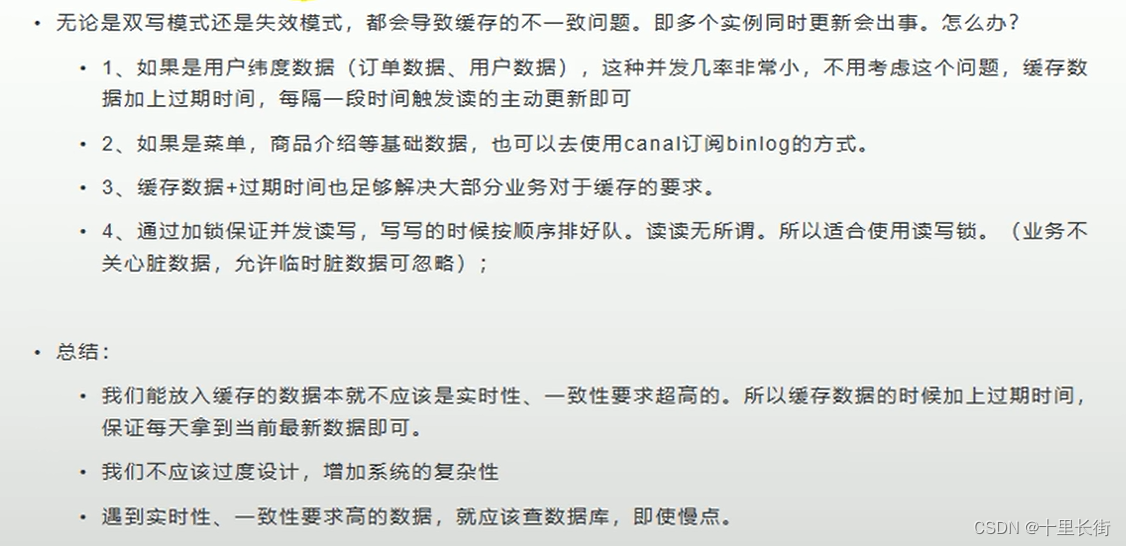
5、缓存数据一致性-解决-Canal
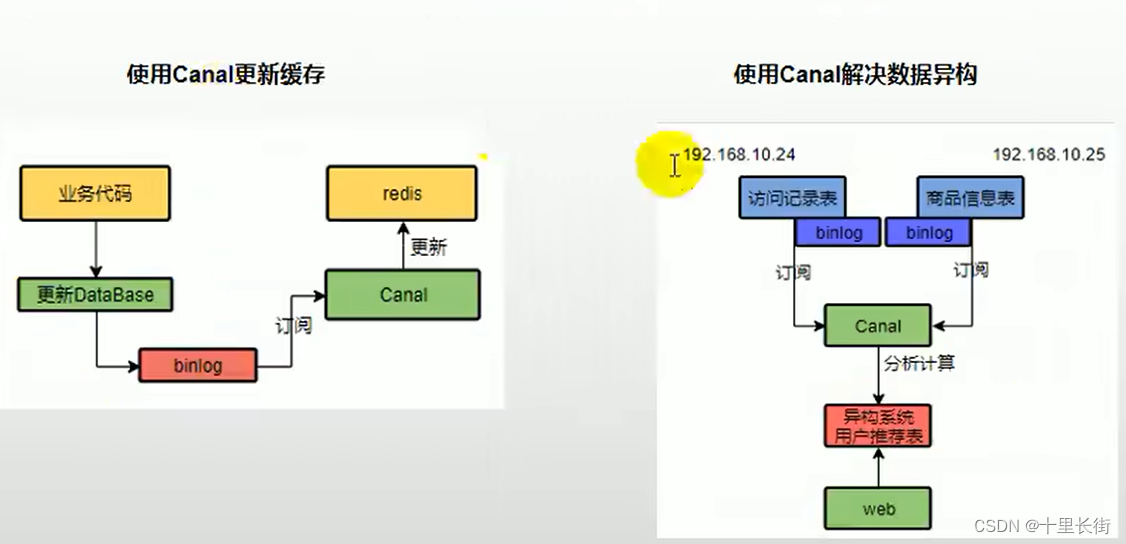
二、Spring Cache简介
1、 Spring 从 3.1 开始定义了org.springframework.cache.Cache和 org.springframework.cache.CacheManager 接口来统一不同的缓存技术;并支持使用 JCache(JSR-107)注解简化我们开发;
2、Cache 接口为缓存的组件规范定义,包含缓存的各种操作集合;Cache 接 口 下 Spring 提 供 了 各 种 xxxCache 的 实 现 ; 如 RedisCache , EhCacheCache , ConcurrentMapCache 等;
3、 每次调用需要缓存功能的方法时,Spring 会检查检查指定参数的指定的目标方法是否已经被调用过;如果有就直接从缓存中获取方法调用后的结果,如果没有就调用方法并缓存结果后返回给用户。下次调用直接从缓存中获取。
4、 使用 Spring 缓存抽象时我们需要关注以下两点;
(1)、确定方法需要被缓存以及他们的缓存策略
(2)、从缓存中读取之前缓存存储的数据
三、Spring Cache基础概念
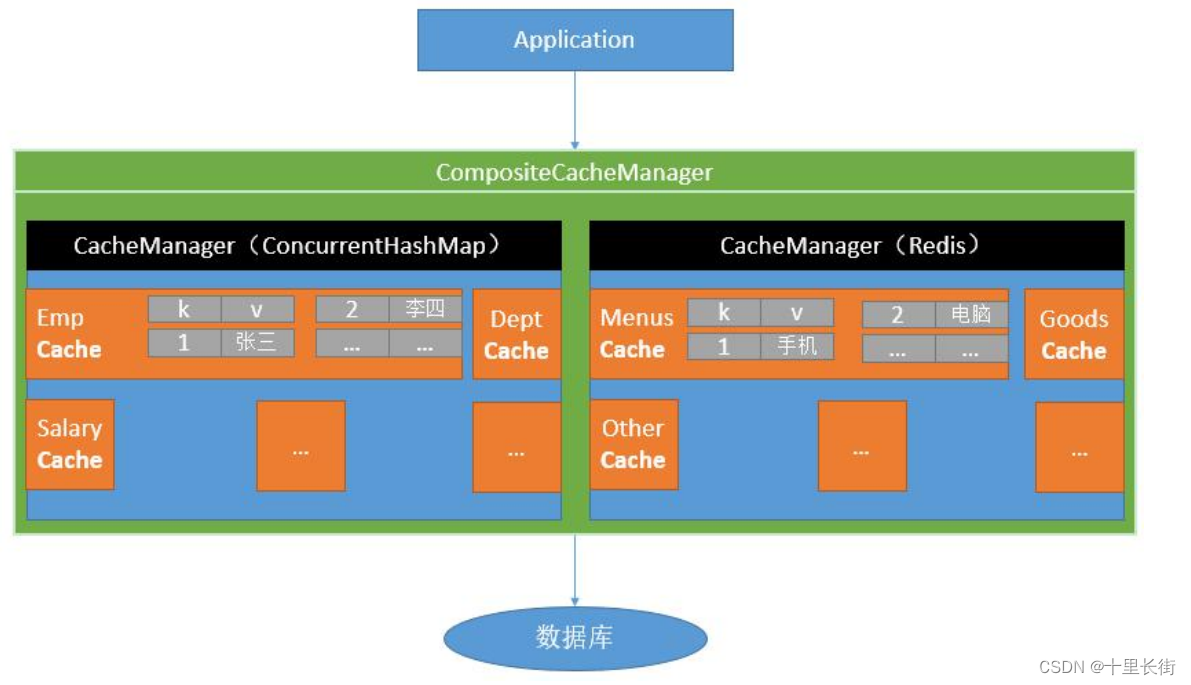
四、Spring Cache注解
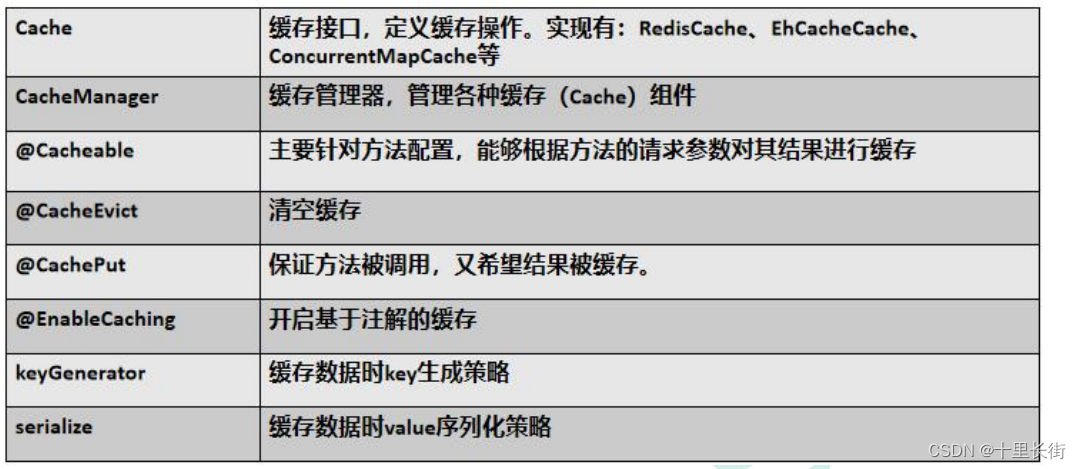
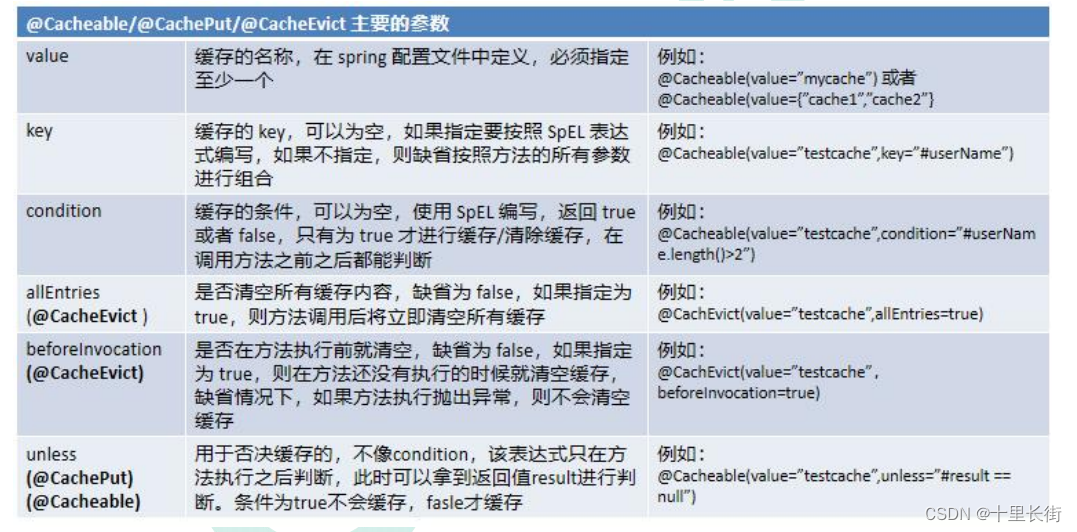
五、Spring Cache表达式语法
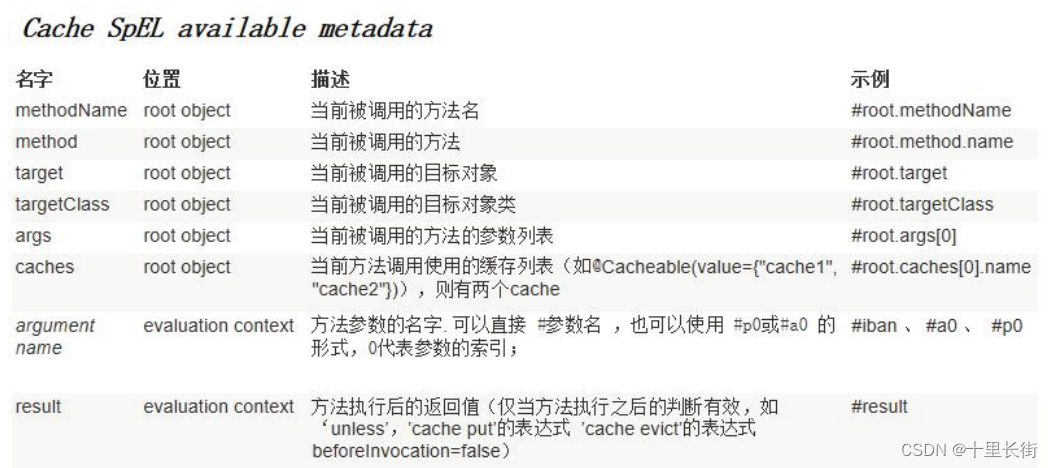
六、整合SpringCache简化缓存开发
1)、引入依赖
<dependency>
<groupId>org.springframework.boot</groupId>
<artifactId>spring-boot-starter-data-redis</artifactId>
</dependency>
<dependency>
<groupId>org.springframework.boot</groupId>
<artifactId>spring-boot-starter-cache</artifactId>
</dependency>
2)、写配置
(1)、自动配置了哪些?
CacheAutoConfiguration会导入 RedisCacheConfiguration;
自动配好了缓存管理器RedisCacheManager
(2)、配置使用redis作为缓存,配置文件:
spring.cache.type=redis
#spring.cache.cache-names=qq,毫秒为单位
spring.cache.redis.time-to-live=3600000
#生产一般不写,如果指定了前缀就用我们指定的前缀,如果没有就默认使用缓存的名字作为前缀
spring.cache.redis.key-prefix=CACHE_
#是否使用key前缀
spring.cache.redis.use-key-prefix=true
#是否缓存空值。防止缓存穿透
spring.cache.redis.cache-nul1-values=true
3)、配置类
原理:CacheAutoConfiguration -> RedisCacheConfiguration ->自动配置了RedisCacheManager->初始化所有的缓存->每个缓存决定使用什么配置->如果redisCacheConfiguration有就用已有的,没有就用默认配置
package com.product.config;
import org.springframework.boot.autoconfigure.cache.CacheProperties;
import org.springframework.boot.context.properties.EnableConfigurationProperties;
import org.springframework.cache.annotation.EnableCaching;
import org.springframework.context.annotation.Bean;
import org.springframework.context.annotation.Configuration;
import org.springframework.data.redis.cache.RedisCacheConfiguration;
import org.springframework.data.redis.serializer.GenericJackson2JsonRedisSerializer;
import org.springframework.data.redis.serializer.RedisSerializationContext;
import org.springframework.data.redis.serializer.StringRedisSerializer;
@EnableConfigurationProperties(CacheProperties.class)
@Configuration
//如果启动类有可将其去除,开启缓存功能
@EnableCaching
public class MyCacheConfig {
// @Autowired
// public CacheProperties cacheProperties;
/**
* 配置文件的配置没有用上
* 1、原来和配置文件绑定的配置类是这样子的
* @ConfigurationProperties(prefix = “spring.cache")
* public class CacheProperties
2、要让他生效
@EnableConfigurationProperties(CacheProperties.class)
* @return
*/
@Bean
public RedisCacheConfiguration redisCacheConfiguration(CacheProperties cacheProperties) {
RedisCacheConfiguration config = RedisCacheConfiguration.defaultCacheConfig();
// config = config.entryTtl();
//key指定序列化
config = config.serializeKeysWith(RedisSerializationContext.SerializationPair.fromSerializer(new StringRedisSerializer()));
//value指定序列化
config = config.serializeValuesWith(RedisSerializationContext.SerializationPair.fromSerializer(new GenericJackson2JsonRedisSerializer()));
CacheProperties.Redis redisProperties = cacheProperties.getRedis();
//将配置文件中所有的配置都生效
if (redisProperties.getTimeToLive() != null) {
config = config.entryTtl(redisProperties.getTimeToLive());
}
if (redisProperties.getKeyPrefix() != null) {
config = config.prefixKeysWith(redisProperties.getKeyPrefix());
}
if (!redisProperties.isCacheNullValues()) {
config = config.disableCachingNullValues();
}
if (!redisProperties.isUseKeyPrefix()) {
config = config.disableKeyPrefix();
}
return config;
}
}
4)、测试使用缓存
@Cacheable: 触发将数据保存到缓存的操作
@CacheEvict: 触发将数据从缓存删除的操作
@CachePut: 不影响方法执行更新缓存
@Caching:组合以上多个操作
@CacheConfig: 在类级别共享缓存的相同配置
4.1)、只需要使用注解就能完成缓存操作
/**
* 1.缓存key指定:每一个需要缓存的数据,我们都来指定要放到那个名字的缓存。【缓存的分区(按照业务类型分)】
* 2.代表当前方法的结果需要缓存,如果缓存中有,方法都不用调用,如果缓存中没有,会调用方法。最后将方法的结果放入缓存
* 3.默认行为
* 如果缓存中有,方法不再调用
* key是默认生成的:缓存的名字::SimpleKey::[](自动生成key值)
* 如:category::SimpleKey[]
* 缓存的value值,默认使用jdk序列化机制,将序列化的数据存到redis中
* 默认时间是 -1:
*
* 4.需自定义操作:key的生成
* 指定生成缓存的key:key属性指定,接收一个Spel
* 如:category::getLevel1Categorys
* 指定缓存的数据的存活时间:配置文件中修改存活时间
* spring.cache.redis.time-to-live=3600000
* 将数据保存为json格式
*
*
* 原理:
* CacheManager(RedisCacheManager)->Cache(RedisCache)->Cache负责缓存的读写
* @return
*/
//如果配置文件配置了spring.cache.redis.key-prefix=CACHE_,则key为CACHE_getLevel1Categorys,value = {"category"}则无用
@Cacheable(value = {"category"},key = "#root.method.name",sync = true)
@Override
public List<CategoryEntity> getLevel1Categorys() {
System.out.println("getLevel1Categorys........");
long l = System.currentTimeMillis();
List<CategoryEntity> categoryEntities = this.baseMapper.selectList(
new QueryWrapper<CategoryEntity>().eq("parent_cid", 0));
System.out.println("消耗时间:"+ (System.currentTimeMillis() - l));
return categoryEntities;
}
4.2 )、Spring Cache注解扩展介绍
/**
* 级联更新所有关联的数据
*
* @param category
* @CacheEvict:删除指定key的缓存,对应失效模式
* @CachePut:更新缓存,对应双写模式,需要有返回值
* @Cacheable:将数据保存到缓存的操作
* 1、同时进行多种缓存操作:
* @Caching
* 2、指定删除某个分区下的所有数据
* @CacheEvict(value = "category",allEntries = true)
* 3、存储同一类型的数据,都可以指定为同一分区
*/
//1.一个一个删除
// @Caching(evict = {
// @CacheEvict(value = "category",key = "'getLevel1Categorys'"),
// @CacheEvict(value = "category",key = "'getCatalogJson'")
// })
//2.批量删除某个分区下的所有数据
@CacheEvict(value = "category", allEntries = true)
@Transactional(rollbackFor = Exception.class)
@Override
public void updateCascade(CategoryEntity category) {
RReadWriteLock readWriteLock = redissonClient.getReadWriteLock("catalogJson-lock");
//创建写锁
RLock rLock = readWriteLock.writeLock();
try {
rLock.lock();
this.baseMapper.updateById(category);
categoryBrandRelationService.updateCategory(category.getCatId(), category.getName());
} catch (Exception e) {
e.printStackTrace();
} finally {
rLock.unlock();
}
//同时修改缓存中的数据
//删除缓存,等待下一次主动查询进行更新
}
总结:Spring-Cache的不足之处:
1)、读模式
缓存穿透:查询一个null数据。解决方案:缓存空数据
缓存击穿:大量并发进来同时查询一个正好过期的数据。解决方案:加锁 ? 默认是无加锁的;使用sync = true来解决击穿问题
缓存雪崩:大量的key同时过期。解决:加随机时间。加上过期时间
2)、写模式:(缓存与数据库一致)
1)、读写加锁。
2)、引入Canal,感知到MySQL的更新去更新Redis
3)、读多写多,直接去数据库查询就行
总结:
常规数据(读多写少,即时性,一致性要求不高的数据,完全可以使用Spring-Cache):写模式(只要缓存的数据有过期时间就足够了)
特殊数据:特殊设计





















 300
300











 被折叠的 条评论
为什么被折叠?
被折叠的 条评论
为什么被折叠?








